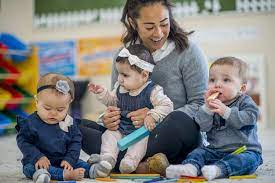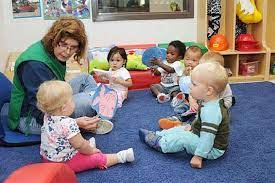Welcoming a baby into a nursery is a significant milestone for both parents and little ones. The Baby Unit Nursery, specifically designed for children aged 3 months and above, plays a crucial role in providing a safe, stimulating, and nurturing environment. In this guide, we’ll explore the essential elements that make a Baby Unit Nursery a haven for the early years of childhood development.
Understanding the Baby Unit Nursery
1. What is a Baby Unit Nursery?
A Baby Unit Nursery is a specialized childcare facility tailored for infants other children aged 3 months and older. It focuses on creating a supportive environment that promotes early learning, socialization, and the overall well-being of babies.
2. Why Choose a Baby Unit Nursery?
Baby Unit Nurseries are designed to meet the unique needs of infants, offering age-appropriate activities, experienced caregivers, and a structured routine that supports healthy development during these crucial early months.
Essential Components of a Baby Unit Nursery
1. Qualified and Trained Staff
A Baby Unit Nursery employs qualified and trained caregivers experienced in early childhood development. These professionals understand the specific needs of infants and provide personalized care to support their growth.
2. Safe and Stimulating Environment
Safety is paramount in a Baby Unit Nursery. The environment is carefully designed to be free from hazards, with age-appropriate toys, soft furnishings, and stimulating visuals to engage and captivate young minds.
3. Structured Daily Routine
Babies thrive on routine, and a well-structured daily schedule ensures that infants in the Baby Unit Nursery receive regular feedings, naps, playtime, and opportunities for sensory exploration.
4. Age-Appropriate Activities
Engaging activities tailored to the developmental stage of each child are a key feature of the Baby Unit Nursery. These may include tummy time, music and movement sessions, and activities that stimulate and develop fine and gross motor skills.
Parental Involvement in the Baby Unit Nursery
1. Open Communication
Effective communication between caregivers and parents is a hallmark of a quality Baby Unit Nursery. Regular updates, including feeding schedules, nap times, and developmental milestones, keep parents informed and involved in their baby’s daily experiences.
2. Parental Visitation Opportunities
Baby Unit Nurseries often provide opportunities for parents to visit and participate in special activities, fostering a sense of community among parents and creating a seamless transition between home and nursery life.
Health and Well-being in the Baby Unit Nursery
1. Hygiene Protocols
Strict hygiene protocols are implemented to safeguard the health of infants. Caregivers follow thorough handwashing procedures, sanitize toys and equipment regularly, and maintain a clean and sanitized environment.
2. Health Monitoring
Regular health check-ups and monitoring ensure that any signs of illness or discomfort are addressed promptly. This proactive approach contributes to the overall well-being of the mother and the infants in the Baby Unit Nursery.
Preparing for Transition to Older Classes
1. Gradual Introduction to Learning
As infants in the Baby Unit Nursery grow, they are gradually introduced to early learning concepts through age-appropriate activities, laying the foundation for a smooth transition to more structured learning environments at school age.
2. Socialization Opportunities
Interactions with peers and caregivers in schools and the Baby Unit Nursery contribute to the development of social skills. As children grow, these socialization opportunities become a valuable foundation for building friendships in future classes.
What is Tax-Free Childcare?
Tax-Free Childcare is a government scheme in the United Kingdom designed to provide financial support to working parents with childcare costs. It operates as a savings account where every £8 deposited by parents is topped up with an additional £2 by the government, effectively offering a 20% boost towards childcare expenses.
How Does Tax-Free Childcare Work?
Parents create a Tax-Free Childcare account online and deposit money into it. The government then contributes an additional 20%, up to a maximum of £500 per quarter for each child (or £1,000 if the child has a disability). These funds can be used to pay registered childcare providers, including nurseries, childminders, and after-school clubs.
Eligibility for Tax-Free Childcare
1. Who is Eligible?
To be eligible for Tax-Free Childcare, parents must meet certain criteria. Both parents must be working, earning at least the equivalent of 16 hours per week at the national minimum or living wage. There are also income limits, and parents must not be receiving support through Tax Credits or Universal Credit.
2. Eligible Childcare Providers
Tax-Free Childcare funds can be used to pay for registered childcare providers. This includes nurseries, childminders, after-school clubs, and holiday clubs. Ensuring the childcare provider is registered is crucial to utilizing the benefits of the scheme.
Applying for Tax-Free Childcare
1. Setting Up an Account
Parents can set up a Tax-Free Childcare account on the government website. The process involves providing essential information, including proof of identity and employment, to verify eligibility.
2. Managing and Using the Account
Once the account is set up, parents can manage deposits, view the government’s contributions, and make payments directly to registered childcare providers. The system is designed to be user-friendly, providing a transparent overview of financial transactions.
Benefits of Tax-Free Childcare
1. Financial Relief
Tax-Free Childcare offers significant financial relief for working parents by effectively reducing childcare costs through the government’s contribution. This can make quality childcare more accessible and affordable.
2. Flexibility in Childcare Choices
Parents have the flexibility to choose from a variety of registered childcare providers. This includes nurseries, childminders, and other services, allowing for personalized and suitable options based on the family and child’s individual needs.
3. Support for Self-Employed Parents
Tax-Free Childcare provides valuable support for self-employed parents and families who may not have access to traditional employer-based childcare schemes. This inclusivity ensures that a broad spectrum of working parents can benefit.
What are Childcare Vouchers?
Childcare vouchers are a form of financial support provided by employers to assist employees in covering the costs of registered childcare. These vouchers can be used to pay for various childcare services, including nurseries, childminders, after-school clubs, and holiday clubs.
Understanding the Needs of Toddlers
1. Independence and Exploration
Toddlers are natural explorers, eager to assert their independence. A well-designed toddler room should encourage exploration while providing a safe and secure environment for curious minds.
2. Routine and Comfort
Establishing routines is crucial for toddlers. A comfortable and familiar space helps them feel secure, promoting better sleep and overall well-being.
Essential Elements of a Toddler Room
1. Safe Sleeping Area
A toddler bed with sturdy railings and a comfortable mattress is essential for a safe and sound sleep environment. Bedding should be age-appropriate, avoiding loose items that may pose a suffocation risk.
2. Accessible Storage Solutions
Low shelves and bins make it easy for toddlers to access and put away toys independently. Labeling storage bins with pictures or words can introduce an early understanding of organization.
3. Soft Play Area
A soft rug or playmat provides a comfortable and safe space for play. This area can be designated for activities like building blocks, playing with toys, or reading.
4. Interactive Learning Spaces
Incorporate age-appropriate educational elements, such as colorful alphabet posters, numbers, and shapes. Wall decals or murals can turn learning into a visually engaging experience.
5. Reading Nook
Create a cozy reading nook with soft cushions and a selection of age-appropriate books. This encourages a love for reading and provides a quiet space for relaxation.
6. Art and Creativity Corner
Set up an art corner with washable art supplies and a low table. This allows toddlers to explore their creative side without constant supervision, fostering independence.
Safety Considerations in a Toddler Room
1. Secure Furniture
Anchor furniture to the wall to prevent tipping. Ensure that bookshelves, dressers, and other heavy items are securely fastened to keep the room safe for exploration.
2. Childproofing Outlets and Cords
Cover electrical outlets and secure cords to eliminate potential hazards. Toddlers are naturally curious, and these safety measures protect them from accidental injuries.
3. Soft Edges and Cushioned Surfaces
Install soft corner protectors on furniture with sharp edges. Opt for soft furnishings and rugs to minimize the risk of bumps and bruises during play.
The Baby Unit Nursery serves as a foundation for the holistic development of infants aged 3 months and six weeks and above. With a focus on safety, stimulation, and parental involvement, it creates a nurturing environment where little ones can thrive, setting the stage for a lifelong love of learning.
FAQs – Addressing Parental Concerns
Q1: How do caregivers handle sleep routines in the Baby Unit Nursery?
A: Caregivers follow a consistent sleep routine, ensuring that babies nap in a safe and comfortable environment. Parents receive updates on their baby or child’s own sleep patterns to maintain continuity at home.
Q2: What types of developmental activities are offered in the Baby Unit Nursery?
A: Activities focus on sensory exploration, motor skill development, and early learning concepts. Tummy time, music sessions, and interactive play are integral components of the developmental program.
Q3: How can parents get involved in the Baby Unit Nursery activities?
A: Parents are encouraged to participate in special activities, attend parent-teacher meetings, and engage in open communication with caregivers to stay actively involved in their baby’s experiences and education.
Q4: How is discipline handled in the Baby Unit Nursery?
A: Discipline in the Baby Unit Nursery is based on gentle guidance, positive reinforcement, and redirection. Caregivers work closely with parents to maintain consistency between nursery and home environments.
Q5: What is the caregiver-to-child ratio in the Baby Unit Nursery?
A: The caregiver-to-child ratio adheres to regulatory standards, ensuring that each baby receives personalized attention and care. This ratio contributes to a safe and supportive environment.



Recent Comments